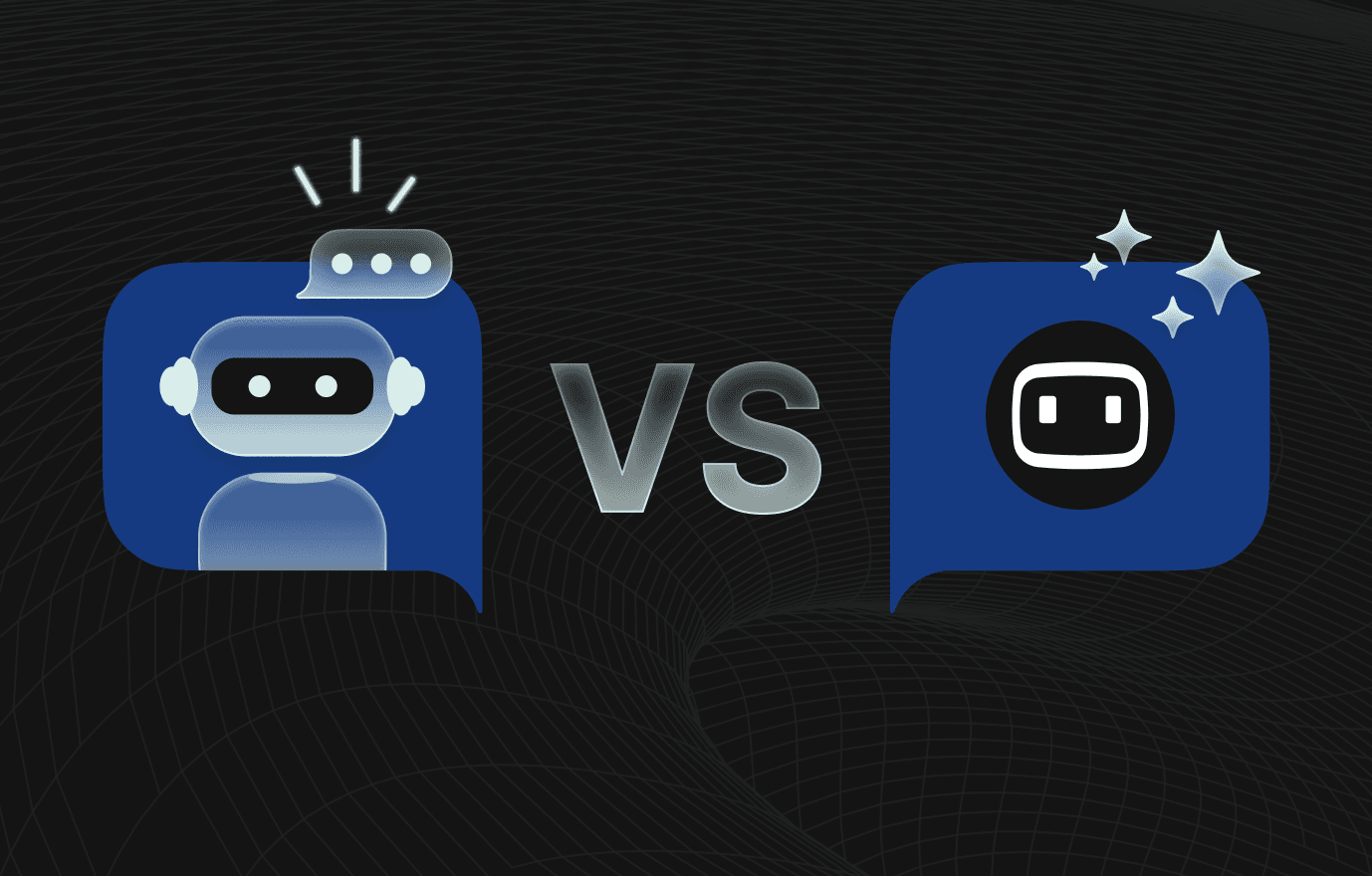SaaS /
20 Min read
Slack vs Teams: Which tool to choose in 2025
May 22, 2023
Bhavyadeep Sinh Rathod
Content Editor, WotNot
Slack vs Teams, this debate is quite old and far from over. Both giants of collaboration and communication have captured the attention of teams worldwide, leaving many in a perpetual dilemma when it comes to making a choice between the two.
So, which one is better? Well, no matter how much I hate to give this answer, but “it depends”. It really does. Complex questions often demand complex answers, requiring thorough research and analysis. But fear not, because we've done the legwork for you.
In this blog, we will explore Slack and Teams, shedding light on their key differences, strengths, weaknesses, and unique features. So, fasten your seatbelts and get ready to delve into this comprehensive piece of content that will help you make an informed decision.
Slack is a modern communication platform that has revolutionized the way teams collaborate and work together.
With its intuitive interface and powerful features, Slack makes it easy for teams of all sizes to communicate, share files, and stay organized in real time. And not only size, Slack is so universal that there is no stereotypical Slack user, as it caters to a diverse audience that includes freelancers, large businesses, non-profit organizations, etc.
From instant messaging and video calls to integrations with your favorite tools and apps, Slack offers a seamless experience that keeps you connected and productive no matter where you are. Say goodbye to endless email chains, missed messages, and disorganized workspaces. With Slack, you can streamline your workflow, boost your productivity, and easily achieve your goals.
Top 7 Slack Features in 2025
1. Advanced Search Modifiers
Slack offers search capabilities that make it easier to locate specific messages in channels that have an accumulation of messages. You can use the search function within a channel by typing "in:" or use other search options such as filtering content by a specific team member with "From:" or searching for messages with links using "Has:link".
Additionally, you can find messages that you have starred using "Has:star" and even search for specific emojis.
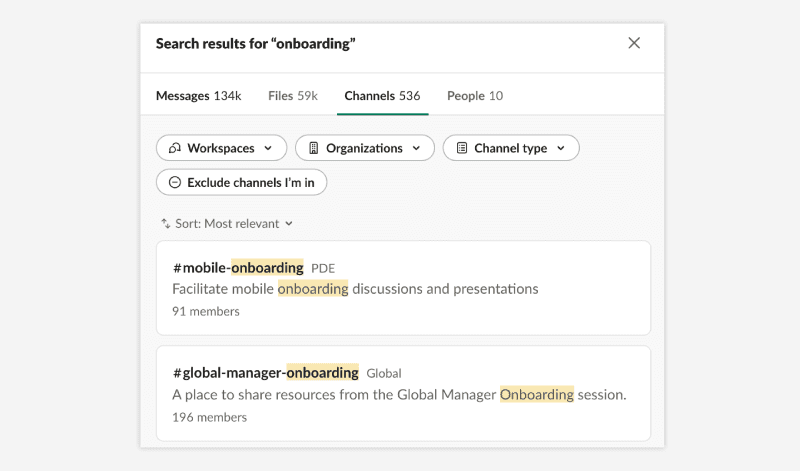
To further narrow down search results, you can put a term in quotes for exact matches, or add an asterisk after a partial word to search for any instances of that fragment. Indexed linked files also allow you to search for their contents in Slack, making it easier to locate relevant information.
For a more comprehensive list of modifiers, refer to Slack's support page.
2. Streamline Sidebar
The sidebar menu in Slack enables you to sort channels and direct messages based on your preferences. By starring important channels, they will appear at the top of the sidebar, ensuring easy accessibility.
You can even group them into collapsible sections.

Moreover, you can customize your sidebar theme to your preference. If bright colors strain your eyes, a muted style may be more suitable. Alternatively, you can create a custom color scheme to celebrate your favorite team's victory or any other preference.
Both the mobile and desktop versions of Slack allow you to adjust your theme and color scheme. To do so, go to Preferences and then Sidebar, where you can select pre-designed themes or create your own.
3. Automated Reminders
The /remind command in Slack is a useful tool for reminding yourself or others of important events, meetings, deadlines, messages, or files. Simply type the command in a channel and specify the task, and Slackbot will send a reminder at the designated time.
I would recommend using reminders as a favorite Slack feature, especially for project managers who need to keep track of daily tasks. Additionally, you can customize your notifications by channel, so you never miss important updates while focusing on your work.
To further customize Slack reminders, you can ask Slackbot to remember and provide quick access to useful information like building Wi-Fi passwords, the nearest coffee shop, or instructions on opening a stubborn closet door.
4. Integration With Third-party Tools
Slack offers project managers the necessary features through integrations with other applications.
Asana, Jira, Pivotal Tracker, Blossom, and Trello are just a few examples of project management integrations available in Slack. You can easily import cards, tasks, conversations, and notifications from other apps to use Slack as your primary platform for getting work done.
In addition, many other integrations are available that can further enhance your productivity. For instance, you can integrate Slack Live Chat.
With Slack Live Chat, you can manage live chat directly from the Slack itself.
Not only this, you can also:
Proactively start conversations on Slack
Manage account-based marketing
Leverage easier collaboration, courtesy Slack
Slack can also link to many of the apps you may already be using such as Google Drive, Google Calendar, WotNot, Dropbox, GitHub, MailChimp, Intercom, ZenDesk, Salesforce, Twitter, and InVision.
Also Read: Live Chat for Slack: A Simpler, Faster, and Better Way to Live Chat
You can even integrate GIPHY into Slack and use secret GIPHY Slack commands to add some humor to your conversations.
5. Task List Management
Just like project management integrations, Slack can also integrate with tools like Wunderlist and Todolist to keep track of deliveries.
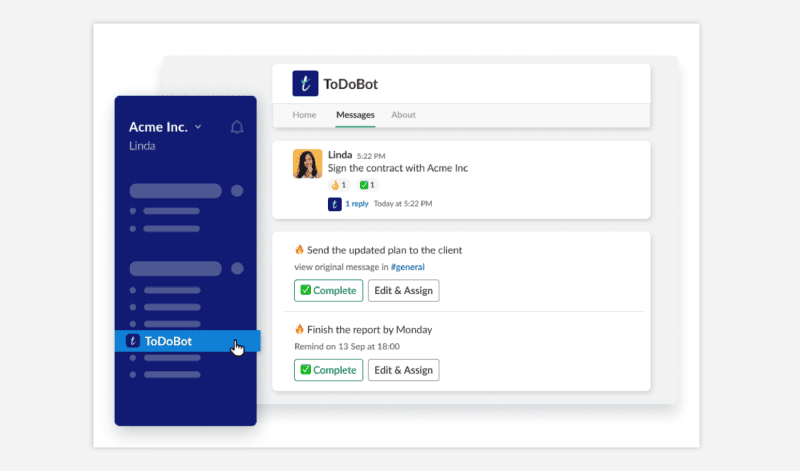
In case, if you don’t want to integrate external tools, Slack allows you to create your own to-do list and use the To-do bot to keep track of your entire list inside of Slack.
To make it easy to find the list again, you can even pin them or add start to a message.
Note: In every channel or direct message, you can pin up to 100 messages, files, or documents. To view the starred messages, hit the ‘Show starred items’ button.
6. Project Management
Slack helps with project management by setting up different channels for the team. You can create a single team channel for your entire company to communicate in.
Or, if your company employs a large number of people, create different teams for each segment of your group.
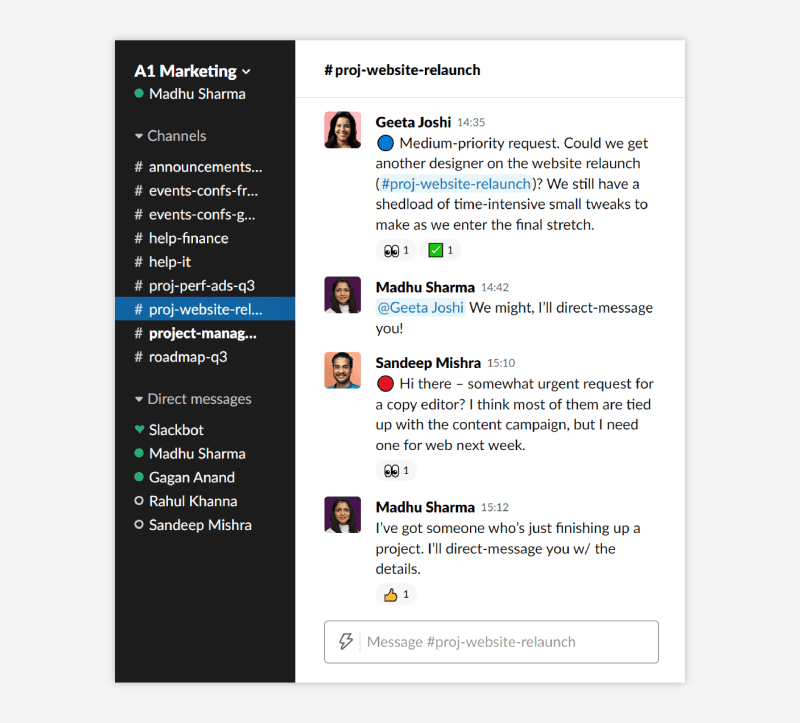
Each team has a number of channels. These are the building blocks of Slack. In essence, they represent a stream of conversations that revolve around a predefined topic.
Channels can be topical, project-based, location-based, integration-based, used by only a certain team, or limited to any other group you’d like.
Slack automatically creates #general and #random channels that can be used across teams. For company-wide project progress, channels like #management, #sales, #marketing, and #accounting might be useful.
You can also create private channels for small groups and one-on-one conversations as needed.
7. Useful Bots
Slack provides an extensive list of bots in addition to integrated apps. Slackbot, for example, can assist you with taking notes and setting reminders.
Other bots available on Slack include DiggBot, which delivers interesting websites and news to your channel, and PaperBot, which organizes links into a single website. Additionally, Spacetime bot assists remote workers with time zone conversions, while Team O'clock facilitates Scrum standup meetings and provides video for distributed teams.
Slack offers a diverse selection of thousands of bots and apps, which can be accessed through the app directory. You can use Api.ai to develop your bot.
Slack's Latest Additions
Apart from the above key features, Slack keeps rolling out new features and updates. Let’s have a look at a few of them.
1. Screen Sharing
Users can now share screens from huddles on desktops and mobile devices to work in real-time with their teammates. Simply, copy and share links to allow users to join from anywhere, like a calendar invitation or a message in Slack.
2. Automate Admin Approval
Members now have the authority to install apps without the workspace owner’s approval. However, you do have the authority to approve and restrict apps on a case by case basis. One can also automate the entire process by configuring rules so that apps only get approved if they meet the assigned category
3. Manage Emoji Preferences
Emoji in Slack can be both enjoyable and useful in completing tasks. To fully utilize the benefits of emoji, you have the option to customize your default skin tone, modify display preferences, and utilize one-click emoji reactions.
4. Share Conversation History While Adding New Members to the Channel
Direct Messages, refer to private conversations between two or more individuals, excluding channels. Slack now features adding additional individuals in a DM and continuing the discussion. Upon adding new members to a DM, messages and files will be accessible to them based on the conversation history that you opt to include.
Microsoft Teams
Microsoft Teams is a collaboration platform that facilitates connectivity, organization, and progress for teams. It allows communication through chat, calls, and meetings from any location and device. The platform boasts several productivity-boosting features, such as file sharing, real-time collaboration, project management tools, and integrations with other applications.
Microsoft Teams is a reliable option whether you are working on a project, hosting a virtual event, or staying in touch with your office colleagues. The platform caters to a broad user base, spanning small businesses to large corporations, and provides a smooth, seamless experience that fosters cohesion and success.
Top 5 Microsoft Teams Features
1. Seamless Office 365 Integration
Teams seamlessly integrates with Microsoft 365, a useful feature for businesses already using it. Microsoft 365 apps such as Word, Excel, PowerPoint, OneNote, SharePoint, and Outlook are incorporated fully into Teams.
For instance, by integrating Outlook, you can move a Teams conversation to Outlook just by clicking the ‘…’ icon, which means ‘more options.’ Similarly, you can also move a conversation in Outlook to Teams―including attachments, by clicking “Share to Teams.”
The integration allows swift creation of teams, retrieval of deleted groups, modification of group email alias, and the use of sensitivity labels.
Employees who prefer Files Explorer can benefit from Teams, which is optimized for this browser, enabling Explorer-view access to OneDrive and SharePoint locations directly from Office suite applications or Explorer.
2. Conversation Threads
Teams organize chats as threaded conversations, allowing for easy tracking of conversation flow without sifting through irrelevant information. Multiple chat rooms and channels can be made within a team, keeping chats clear.
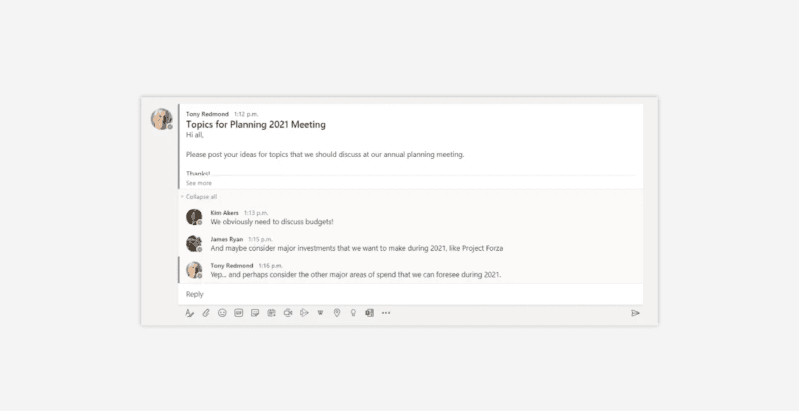
To enhance the experience, Teams offer conversational threads that progress from top to bottom. This greatly enhances readability. Users are updated on changes and may switch to a voice or video chat with one click if needed. Teams display up to 49 people on a single screen, and 250 can join a video conference.
3. Slash Commands
In fast-paced work environments, efficiency is highly valued. Microsoft Teams offers a useful feature called slash commands, which is a short typed phrase preceded by a slash ‘/’ that triggers specific actions within an app.
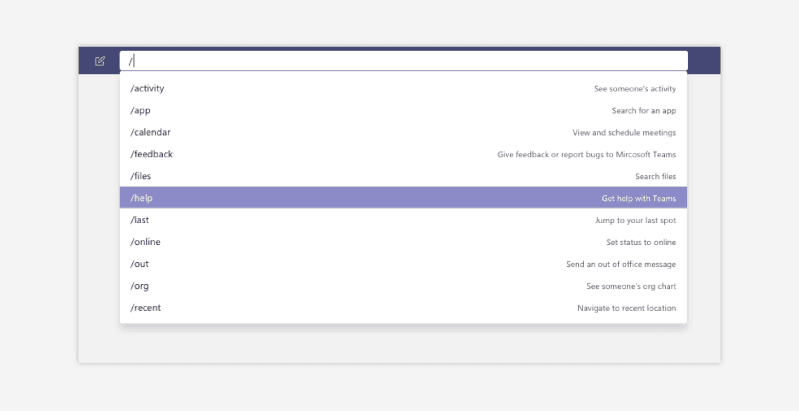
The primary purpose of slash commands is to quickly execute everyday functions without the need to take your hands off the keyboard. While “/away” is the most common slash command, it offers several other functions, such as joining a channel, inviting other users to a channel, and marking oneself as busy/available/away.
Slash commands in chat apps increase productivity by providing several functions, making them valuable tools for fast-paced environments.
4. Grid View
Microsoft Teams provides a new, simpler approach to managing your teams. It allows you to access all your teams in a centralized location, including classes, PLCs, staff, etc. You can choose any team to concentrate on conversations and files without additional visual interference while all your files, discussions, and tasks remain in their original locations. Moreover, you can always revert to the previous view.
5. Advanced Cyber Security
Microsoft Teams has implemented several cyber security standards such as ISO 27001 and SSAE16 SOC I and II. Moreover, Teams also offers mobile device management to ensure data and fleet security.
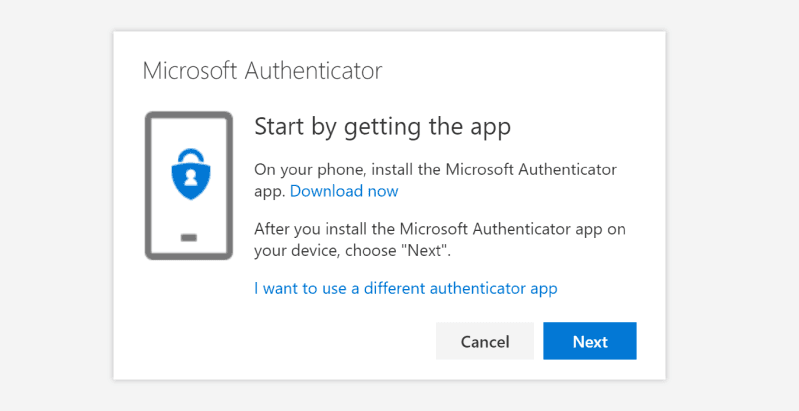
Multi-factor authentication, single-on, and data encryption are utilized to protect business information from malware and ransomware attacks. Malware is dangerous—it can access sensitive data and even spy on you. If you see laptop camera light on unexpectedly, someone may be recording you. Additionally, Teams backups and stores data, so no data gets lost during an outage. Using Microsoft Defender for 365, Safe Links allows URL scanning and verification, an extra layer of security against malicious links used in phishing and other cyber attacks.
Teams' Latest Additions
Along with a fully decked up document storage, chat, and online meeting environment, Microsoft Teams keep updating its feature stack. Let's have a look at their latest additions.
1. Enhanced Webinar Management Experience With Customized Options
Upon selecting the webinar template, you will notice a new layout and expanded options that enable you to tailor registration details and event-specific settings. With this enhanced management experience, you will have access to the following capabilities to configure your webinar.
You can effortlessly assign co-organizers to support the coordination and delivery of your event.
Exhibit your brand and match the theme of your event by utilizing a banner, logo, and suitable color scheme that will appear on your registration page and webinar communications.
You can establish registration capacity limits for up to 1,000 attendees and include comprehensive custom questions to collect relevant information about your potential attendees. Additionally, you can add a specific question for uploading terms and conditions and obtain consent from attendees during the registration process.
2. Federated Group Calling
You can effortlessly initiate a group Teams call from a chat with external federated colleagues, enabling video and screen sharing. The call can be made over an internet connection without any usage charges for PSTN.
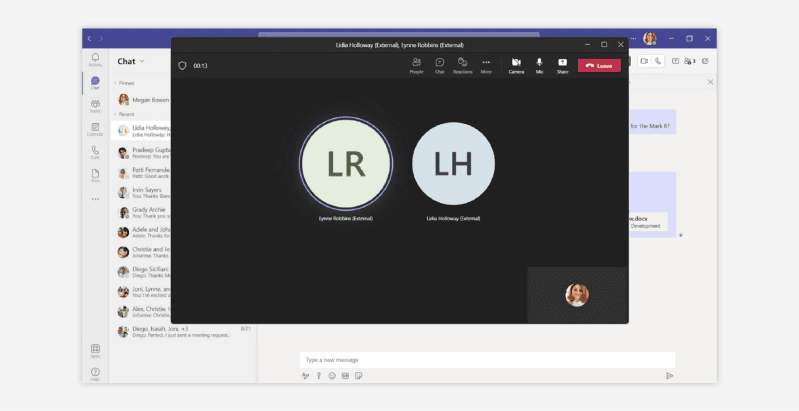
3. Start Whiteboard From a Teams meeting
Users of Teams Rooms on Windows can now launch a Microsoft Whiteboard in Teams meetings by using the one-touch in-meeting share content feature from the consoles in the meeting room. As we embrace new work patterns, whiteboarding has become an essential tool for promoting collaboration between remote and in-room users.
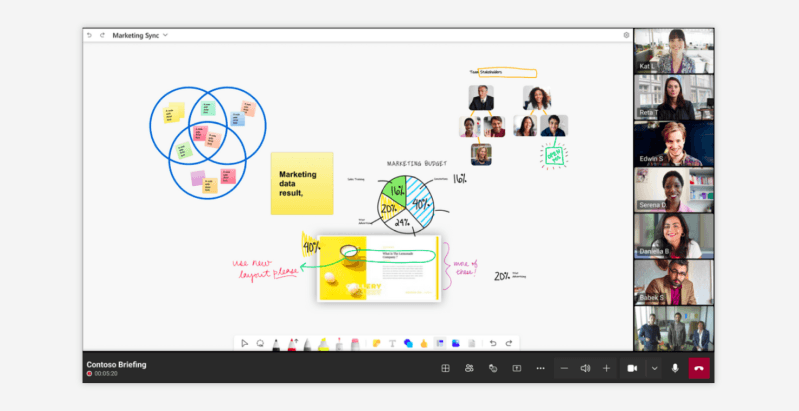
4. View the Full Chat Conversation Thread
When users search for a chat message in Teams and click on a message result, they will now be able to view the complete conversation context associated with the result, regardless of the message's age.
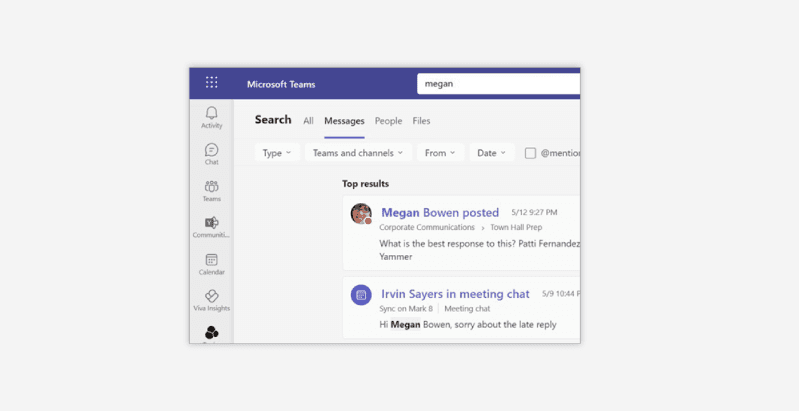
Slack vs Teams: Market Share
The usage of Slack and Microsoft Teams has significantly increased in small, medium, and large companies. Microsoft Teams has become the most popular business communication platform with 270 million users as of 2022, surpassing Slack's 18 million active users.
A research study was conducted to compare engagement levels at the feature level between Slack and Teams.
The results were notable:
Private messages: 89% of engaged Slack users interacted with private messages over 30 days compared to 60% for Teams.
Group messages: 92% of engaged Slack users used the group messaging feature over 30 days, while only 11% of engaged Teams users used it.
Meeting attendance: 62% of engaged Teams users attended a meeting over 30 days, while only 13% of engaged Slack users attended a meeting.
Slack vs Teams: Feature Comparison
1. Slack vs Teams: User Interface
Both Slack and Teams desktop apps have easily navigable interfaces, with messaging as their main focus. However, there are some differences in style. Slack has a more freeform and flexible design that some may find disorderly, while Teams has a more structured and corporate appearance that may seem generic but streamlined.

In terms of customization, Slack offers more options to modify the sidebar's look and content display, such as including all direct messages and sorting content. Conversely, Teams provides only three customization options: default (light), dark, and high contrast.
Winner: Slack 🥳
Reason: Slack’s interface is more visual than Teams.
Score: Slack vs Microsoft Teams: 1:0
2. Slack vs Microsoft Teams: Navigation
Both clients have navigation sidebars on the left-hand side, with Teams putting more focus on the work teams while Slack emphasizes channels, which are work areas users create around projects, topics, or teams.
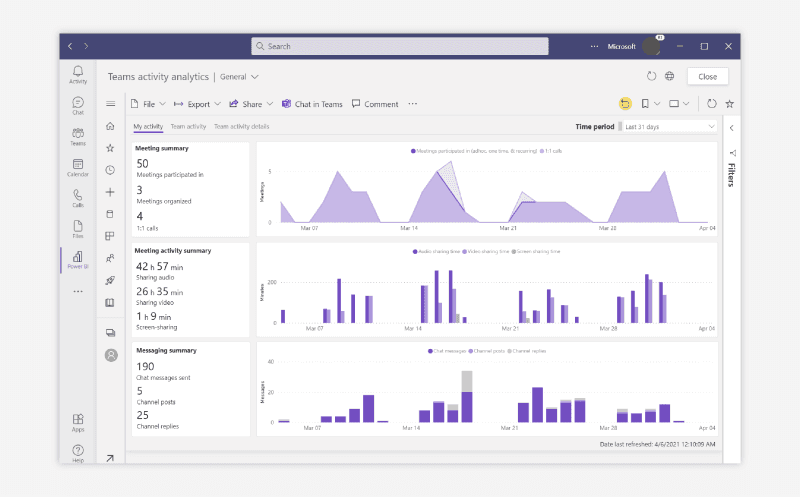
Teams' sidebar features icons for Activity, Chat, Teams, and Files, with the possibility of adding Calendar, Calls, and more. The Activity dashboard gives an overview of everything happening in the organization, with a filter option to see conversations in which the user has been involved. The top-line navigation on Teams includes tabs for Conversations, Files, and a team wiki.
On the other hand, Slack's sidebar includes links to channels, threads, direct messages (DMs), and other options such as "All Unreads," displaying all unread messages in a single feed. The sidebar also offers easy access to the automated chatbot for help, Slackbot.
Winner: Tie 💪
Reason: Both offer quick accessibility to all the important tabs.
Score: Slack vs. Teams: 2:1
3. Slack vs Teams: Communication
Messaging plays a crucial role in both products, and they perform well in this area. However, there are some distinguishing features, let’s discuss them one by one.
Both platforms provide text formatting capabilities for writing messages. In Slack, users can access these options by clicking the "Aa" icon beneath the text-entry box. In Teams, users can click the icon resembling an "A" with a paintbrush over it.
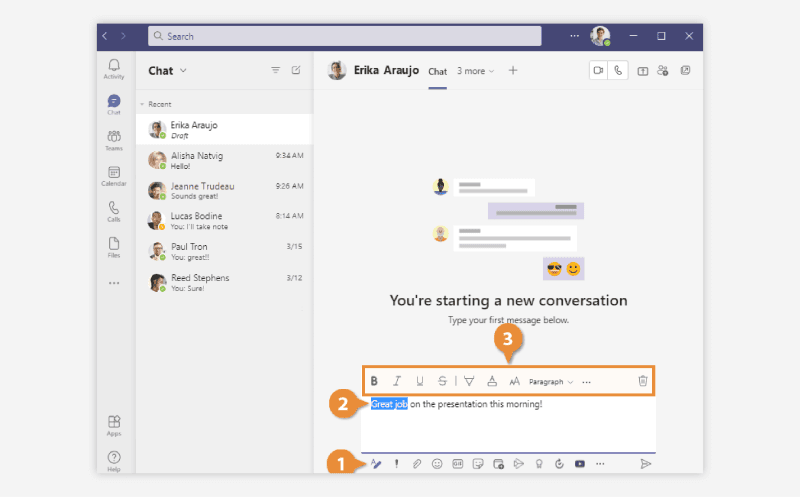
While Teams offers more advanced word processing-like formatting options, such as font color selection, three font sizes, table insertion, undo and redo typing, and paragraph styles, Slack's simpler formatting options may suffice for some users.
Slack limits the chat history to 10,000 messages in a free plan, while Teams provide unlimited chat history for free.
Both platforms allow users to include emojis in their messages, with additional options natively, such as integration with GIPHY for animated GIFs.
Considering voice and video chat options, Slack is quite limiting even with its paid plan. It allows users to integrate with Zoom, Webex, Google Hangouts, and other apps. Meanwhile, Teams offers built-in videoconferencing and other options, including the ability to use Microsoft's cloud-based Phone System to call individuals outside of the organization. Depending on how Slack or Teams is configured, users can record video chats and calls and obtain transcriptions.
Winner: Teams 😎
Reason: Slack provides limited options in terms of chat history, formatting options, and doesn't even fit more than 15 people in one call.
Score: Slack vs Teams: 2:2
4. Slack vs Teams: In-app Help
Teams provides a Help icon in the sidebar with links to Topics, Training, and What's New, which is well-organized and offers easily accessible help content without the need for searching. Each article on the Training tab specifies the time required to read it, so users can decide beforehand whether it's worth their time.
On the other hand, Slackbot, an in-app chatbot, is simple to use. Just type a DM with a keyword or question and Slackbot usually provides an answer within seconds. In our experience, Slackbot missed the mark only once or twice in dozens of queries.
Winner: Slack 🥳
Reason: Having documentation is old school. In-app bots are the new way, and thus, we are giving Slack a slight edge over Teams.
Score: Slack vs Teams: 3:2
5. Slack vs Microsoft Teams: Notifications
It is important to have control over notifications in messaging apps to avoid being intrusive. Teams and Slack provide notification settings, but Teams has more granular controls. You can choose the type of notifications to receive and how to receive them in Teams.
Meanwhile, Slack has fewer notification options, but you can customize notification settings for mobile and desktop separately and be notified when someone uses a specific keyword.
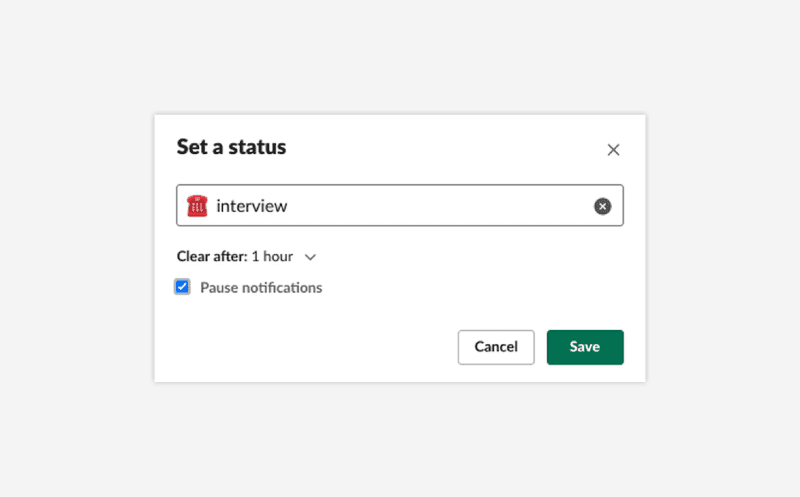
Both Slack and Teams offer the Do Not Disturb feature. Slack provides flexible options to silence incoming notifications for specific durations or set a notification schedule to receive notifications only during designated hours and days.
On the other hand, Teams allows you to mute all notifications during quiet hours and quiet days, but these options are available only on the Teams mobile app.
Lastly, Slack has an automatic push notification feature when the user is inactive for a specified time, whereas Teams provides the option to toggle mobile notifications on and off for Mentions, Calls, and Meetings and to mute mobile notifications during a meeting or when using the desktop app.
Winner: Slack 🥳
Reason: No doubt, Teams has granular controls, but when it comes to configuration, Slack did a great job!
Score: Slack vs. Teams: 4:2
6. Slack vs Microsoft Teams: Search
Both offer great search capabilities. But Slack search feels more robust to us, especially if you’re used to fine-tuning Gmail search results. For example, in Slack you can search using modifiers such as from:@username or before:8/31/2021.
Microsoft, on the contrary, is upping the game with its new search and filtering function. By finding relevant information, it lets users schedule meetings for members where everyone is automatically invited.
Winner: Slack 🥳
Reason: Slack helps sort through information like a breeze!
Score: Slack vs Teams: 5:2
7. Slack vs Microsoft Teams: Security and Privacy
When it comes to security, compliance, and enterprise management, many assume that Microsoft Teams is the superior option due to its lengthy tenure in the enterprise sector. This is particularly true for Microsoft 365 subscribers who receive high-quality security, compliance, and enterprise management controls.
However, both Slack and Teams now provide many of the necessary security and compliance features. Both platforms encrypt data in transit and at rest, support data residency based on location, include data loss prevention, eDiscovery and legal hold, mobile application management, single sign-on, and the ability to require two-factor authentication. Some of these features are only available with higher-tier plans.
Slack is also enhancing its security features, offering the Enterprise Key Management add-on tool for its top-tier Slack Enterprise Grid plan, which allows organizations to use their own keys for encrypting messages and files shared within Slack. Additionally, Slack's mobile security features, available for Enterprise Grid, enable administrators to configure Slack to require extra layers of security after single sign-on, such as Face ID and Touch ID on iOS.
In summary, Slack provides adequate security, compliance, and administrative controls for most small to midsize businesses (SMBs), with continuous improvements to its security posture. However, Microsoft Teams, thanks to its integration with Office 365 and Microsoft 365, may be the ideal choice for large enterprises.
Winner: Teams 😎
Reason: Microsoft Teams would protect your data better, due to its robustness and diverse integrations.
Score: Slack vs. Teams: 5:3
8. Slack vs Teams: Integration With Other Tools
Slack and Teams offer several integrations with other apps and services to enhance their features. There are notable differences between the two products, particularly with regard to productivity suite integration.
Teams offers comprehensive integration with Microsoft 365/Office 365 apps, such as Word, Excel, and PowerPoint, making it the winner in this area. Users can collaborate with colleagues in real time while working on files. Teams also integrates with Dynamics 365, Microsoft’s CRM platform.
Slack offers integration with some Microsoft apps, including Outlook calendar and email, OneDrive, and SharePoint, but not to the same extent as Teams. On the other hand, Slack excels in integrating with Google apps such as Gmail, Google Drive, and Google Sheets. It also offers a live chat integration along with a deep integration with Salesforce, which includes a Slack app for Salesforce to view Slack messages associated with a Salesforce record.
Slack offers more than 2,400 third-party app integrations, whereas Teams has about 700. Both products allow customers to build their own custom apps and integrations. Slack reported that 935,000 custom apps were built by customers and used in a typical week as of September 2021, while Microsoft enables custom apps and integrations via its Power Platform developer tools.
Winner: Slack 🥳
Reason: Slack provides approx 4X times integrations of Teams.
Score: Slack vs. Teams: 6:3
9. Slack vs Microsoft Teams: Pricing
Both Slack and Teams offer free plans, with Teams’ plan providing unlimited messages, meetings, and search; support for up to 500 internal and external users; 2GB of file storage per user and 10GB of shared storage, while Slack’s free plan is more restrictive, allowing up to 10,000 messages; 10 apps and integrations; one-to-one video calls; and two-factor authentication.
Slack’s paid plans start at $7.25 per user per month for the Pro plan and $12.50 per user per month for the Business+ plan, which offer more features such as unlimited messages and integrations, guest access, and advanced search. The Enterprise Grid plan, which is designed for large organizations, is available only by contacting Slack sales.
Microsoft offers various business subscription plans that include Teams, with prices ranging from $4 per user per month. These plans include other apps and services in the Microsoft 365 ecosystem, and features such as scheduled meetings, meeting recording, and security and administration features.
An eye-to-eye comparison of the plans is challenging due to the differing features. However, for $12.50 per user per month, Microsoft offers the Microsoft 365 Business Standard subscription, which includes Teams and other apps like Outlook, Word, Excel, PowerPoint, SharePoint, OneDrive for Business, Publisher, and Access.
Meanwhile, Slack’s Business+ subscription supports unlimited users and includes more Slack features than the Pro plan but fewer than the Enterprise Grid plan.
In conclusion, if your company already has an Office 365 or Microsoft 365 subscription, Teams may be the more cost-effective option. However, if your company uses another office suite, Slack could be a more viable option. If your organization uses Salesforce, Slack's superior integrations may be more beneficial.
Winner: Teams 😎
Reason: Microsoft Teams is affordable and feature rich.
Score: Slack vs Teams: 6:4
Other Notable Features
Slack and Teams are constantly developing new features to differentiate themselves, so it's impossible to provide a complete list.
However, there are some noteworthy features to highlight.
1. Shared Channel
Slack's shared channels feature allows easy collaboration with external partners by connecting your company's workspace with theirs. External participants are easily identified by their company logo in their profile picture.
2. Capabilities to Help First-line Workers
Conversely, it's more complicated to communicate with external parties in Teams, as external access or guest access must be added. External access permits communication through voice or video chat and setting up meetings with other organizations that use Teams, Skype for Business, or Skype. Guest access permits adding an individual outside of your domain to channels and communicating with them through calls or files.
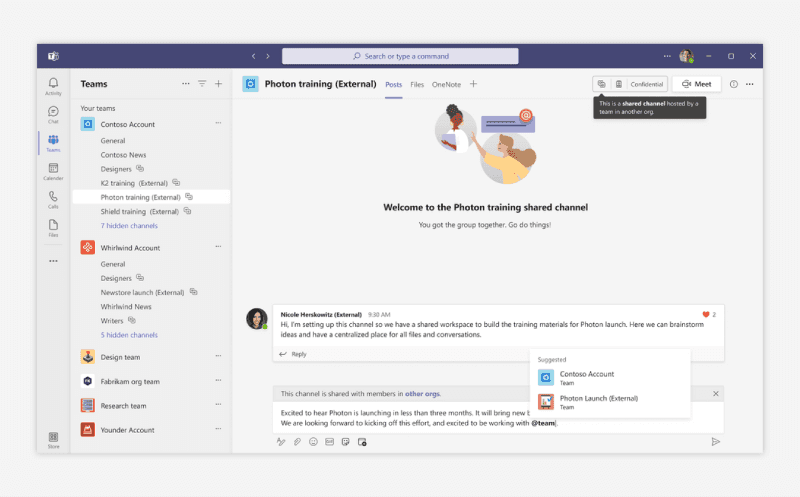
Microsoft has introduced its own shared channels feature, Teams Connect, but it's still in a private preview since its announcement in March 2021.
3. Scalability
Slack has the capability to support an unlimited number of users per organization, channels per workspace, and over 100,000 users on a channel. Teams can support an unlimited number of users per organization, with each team having up to 25,000 participants, 200 channels per team, and 5,000 users on a channel.
Teams offer features that cater to firstline workers in retail, hospitality, travel, and manufacturing. Workers can easily clock in and out on their mobile devices, share their location, and perform other tasks specific to their duties. Slack offers app integrations such as AttendanceBot for first line workers.
Teams offers an integrated Wiki feature for note-taking, while Slack offers team knowledge gathering through app integrations like Guru.
Teams provides message translation in 36 languages, while Slack integrates with various translation apps like Rozetta Translator bot.
Conclusion
In terms of the sheer number of active users, Microsoft Teams has surpassed Slack and is now the market leader, making it the preferred collaboration platform for many businesses. However, Slack remains a popular tool in startups and smaller companies due to its innovative features and user-friendly interface.
Slack boasts a greater number of integrations, a superior bot, and slightly better usability compared to Microsoft Teams. On the other hand, Microsoft Teams is more affordable, offers marginally better free plans, and natively integrates with Office 365 tools.
Slack has more notable differentiators than Teams, such as shared channels. However, when Microsoft releases Teams Connect, this differentiator will cease to exist. The choice between the two will depend on which capabilities are more important for your organization.
When deciding between Microsoft Teams and Slack for your business, it ultimately depends on whether you use Office 365 and how much experience your team has with either platform.
ABOUT AUTHOR
Bhavyadeep Sinh Rathod
Content Editor, WotNot
He likes technology, chatbots, comedy, philosophy, and sports. He often cracks hilarious jokes and lightens everyone's mood in the team.



